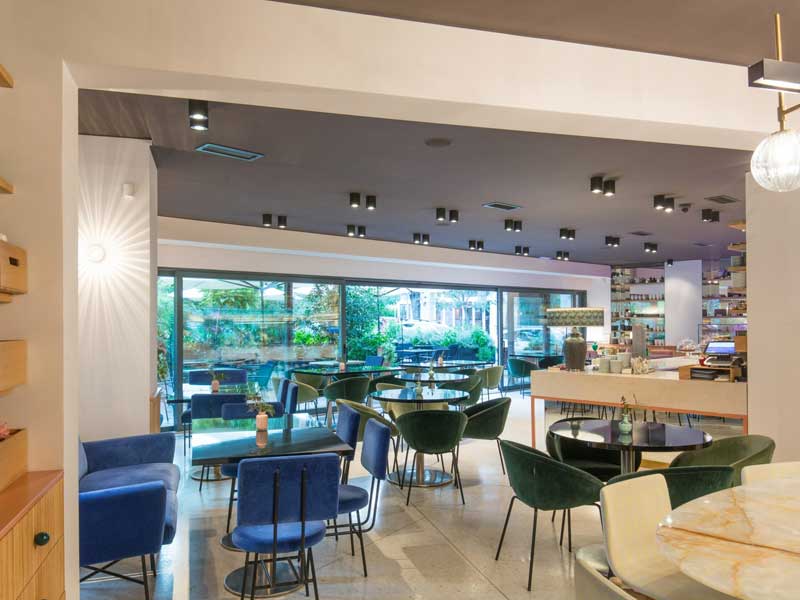
Blogs

Lack of Flexibility: Adaptable in Restaurant Design and Build for Changing Restaurant Needs
The industry of food and beverages is ever-evolving, where trends shift rapidly and customer preferences change, the ability to adapt is a crucial aspect of success.
A restaurant design and build in Dubai plays a pivotal role in creating a memorable dining experience, but the lack of flexibility can lead to missed opportunities and stagnant growth. In this blog, we'll explore the drawbacks of rigid interior designs that struggle to keep up with changing trends and events. We'll also delve into the benefits of embracing adaptable layouts and modular furniture, offering insights that will empower restaurant owners and designers to future-proof their establishments.
The Pitfalls of Rigid Interior Designs in Restaurant Design and Build
- Stagnation in Style
The allure of novelty is an inextricable facet of contemporary culture, extending its influence to the very spaces in which we dine. Restaurants tethered to unchanging interior designs find themselves at odds with the ebb and flow of design trends. As design aesthetics continuously morph to reflect current tastes and innovations, establishments sporting fixed designs risk the danger of appearing passé and disconnected from the zeitgeist. Modern patrons, attuned to the latest design sensibilities, are drawn to spaces that breathe freshness and innovation.
- Missed Event Opportunities
Beyond the everyday dining experience lies the realm of special events, soirées, and themed extravaganzas. However, an inflexible interior design can cast a shadow over the potential success of such endeavors. Whether it's hosting live music nights, pop-up art exhibitions, or culinary workshops, a rigid design that doesn't pivot to accommodate varying themes and spatial needs limits the capacity to generate revenue through diverse events.
- Inflexible Space Allocation
Dining preferences are as varied as the individuals that patronize restaurants. The absence of adaptability in interior layouts means an inability to nimbly adjust to varying party sizes, seating arrangements, and group dynamics. In a landscape where diners seek spaces tailored to their specific needs, an interior design hampered by rigidity can alienate potential patrons.
- Costly Renovations
When the winds of change blow through the realm of interior design, restaurants with rigid infrastructures are often left grappling with a significant quandary: to remain relevant, a costly and time-consuming overhaul becomes an inescapable necessity. The toll of substantial renovations goes beyond financial implications, often causing establishments to shutter temporarily, which can lead to a loss of loyal customers and diminished revenue streams. This reality underscores the importance of a design approach that embraces change in a more seamless and organic manner.
The Power of Adaptability in Restaurant Design and Build
- Staying Current with Trends
In a world where trends shift like shifting sands, staying attuned to the latest design aesthetics is imperative for restaurants aiming to remain relevant and alluring. Adaptable design acts as a responsive canvas that can seamlessly absorb the strokes of new trends and aesthetics. Unlike rigid designs that necessitate significant overhauls to reflect the changing winds of style, adaptable layouts offer a nuanced solution. Elements like furniture, lighting, and decor can be updated or replaced without necessitating major renovations by interior decoration companies in Dubai. This agility allows restaurants to infuse their spaces with a contemporary charm, resonating with a broad spectrum of customers who are drawn to the allure of the latest design fashions.
- Seamless Event Hosting
The hospitality industry's ability to transform ordinary spaces into magical realms for special occasions is a hallmark of its allure. Adaptable interior design, particularly facilitated by modular furniture and versatile layouts, unveils a realm of endless possibilities for event hosting. Imagine a restaurant seamlessly shifting from a cozy fine-dining setup to an engaging cocktail soirée within hours. The ability to cater to a diverse array of events not only maximizes the restaurant's revenue potential but also establishes it as a dynamic hub for community gatherings and celebrations.
- Dynamic Seating Arrangements
Dining dynamics are as diverse as the patrons themselves. The beauty of adaptable layouts lies in their capacity to fluidly accommodate different party sizes and seating arrangements. By incorporating adjustable tables, movable partitions, and flexible seating options, restaurants can effortlessly transform their spaces to cater to the varying needs of their guests. This adaptability, ranging from intimate tête-à-têtes to accommodating large gatherings, enhances the restaurant's versatility and optimizes space utilization.
- Enhanced Customer Experience
In a landscape where dining out is as much about the experience as it is about the cuisine, customer comfort and satisfaction take center stage. Adaptable designs are inherently customer-centric, as they prioritize not just the visual appeal but the ergonomic comfort of patrons. Personalization is key, and a restaurant that can modify its ambiance to suit individual preferences fosters a sense of loyalty and attachment among its clientele. This tailor-made experience translates into positive word-of-mouth recommendations, a potent currency in the world of hospitality.
- Cost-Efficiency
The financial implications of a design overhaul can be daunting, especially for smaller establishments. Adaptable design offers a pragmatic solution by sidestepping the need for grand-scale renovations. Incremental changes, such as replacing furniture pieces or altering layouts, can be accomplished without significant financial strain. This approach not only minimizes costs but also reduces downtime, ensuring that the restaurant's doors remain open and revenue streams continue to flow while the space evolves.
Implementing Adaptability in Restaurant Design and Build
- Modular Furniture
The cornerstone of adaptability in restaurant design lies in the choice of furniture. Modular furniture is akin to a design chameleon, effortlessly adapting to the requirements of different occasions. Think of modular seating that can be rearranged from cozy nooks for intimate dinners to spacious configurations for larger groups. Collapsible tables that expand or contract based on party sizes add a layer of practicality, while movable dividers offer privacy when needed or open up space for communal interactions. The beauty of modular furniture is its capacity to redefine the spatial dynamics of a restaurant without requiring major investments or structural changes.
- Multi-Functional Spaces
The concept of multi-functionality resonates deeply with adaptability. Turnkey fit out contractors in Dubai design spaces that can wear different hats based on the time of day or the event at hand maximizes the utility of each square foot. For instance, a bar counter can gracefully transform into a communal workspace during daylight hours, catering to freelancers and remote workers. This flexibility ensures that the restaurant's real estate isn't limited to meal times alone, but rather, it evolves to serve diverse needs throughout the day.
- Neutral Base with Accent Elements
Imagine the restaurant's interior design as a blank canvas punctuated with vibrant strokes of changing accent elements. By starting with a neutral base design—comprising subdued colors, versatile textures, and timeless design elements—you create a versatile backdrop. This backdrop, like a classic art piece, becomes a stage for accent pieces that can be easily swapped out to mirror evolving trends or thematic events. The neutral base acts as a unifying thread, allowing the restaurant to evolve stylistically while maintaining a coherent and welcoming atmosphere.
- Technology Integration
In an increasingly digital world, technology isn't just a tool but a powerful facilitator of adaptability. Consider the integration of adjustable lighting systems that effortlessly transition from a romantic evening ambiance to a vibrant and energetic setting for live events. Technology extends to sound management, where acoustic solutions can be adapted for both intimate gatherings and lively celebrations. Furthermore, digital displays can be strategically positioned to showcase changing menus, themes, or artworks, allowing the restaurant to metamorphose with a few taps on a screen.
Creating Resilient Dining Experiences with Adaptable Restaurant Design
Adaptable design isn't just a trend; it's a strategy for longevity in the competitive restaurant industry. The drawbacks of rigid interior designs are clear, but the benefits of embracing flexibility are even more compelling. Commercial interior design company Dubai for restaurants that prioritize adaptability position themselves to evolve with customer preferences, capitalize on events, and effectively manage changing trends. By incorporating modular furniture, flexible layouts, and versatile design elements, restaurant owners and designers can create spaces that are not only visually appealing but also future-proofed for success. They can also navigate change efficiently, maximizing cost-effectiveness while elevating their appeal. This embrace of adaptability not only ensures restaurants' relevance but also positions them as dynamic havens of hospitality, primed for innovation and longevity in an ever-evolving dining world. Hire the best interior designers from Coral Supplies and Interiors LLC to assist in creating adaptable designs for your restaurant, coffee shop or cafe at 04 258 8732.
Do you want us to get back to you?
Feel free to call us on +971 4 262 5261 or send an email to info@csiuae.ae and our sales consultant will get back to you.
Get in Touch
